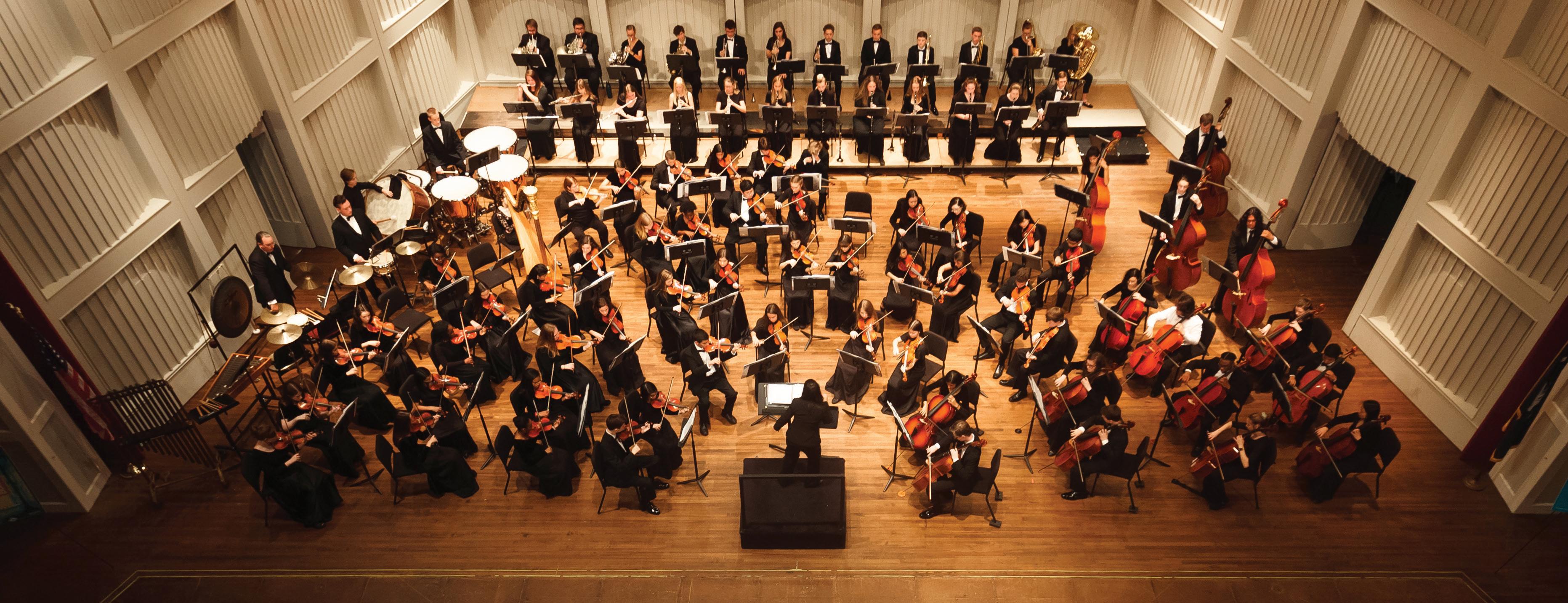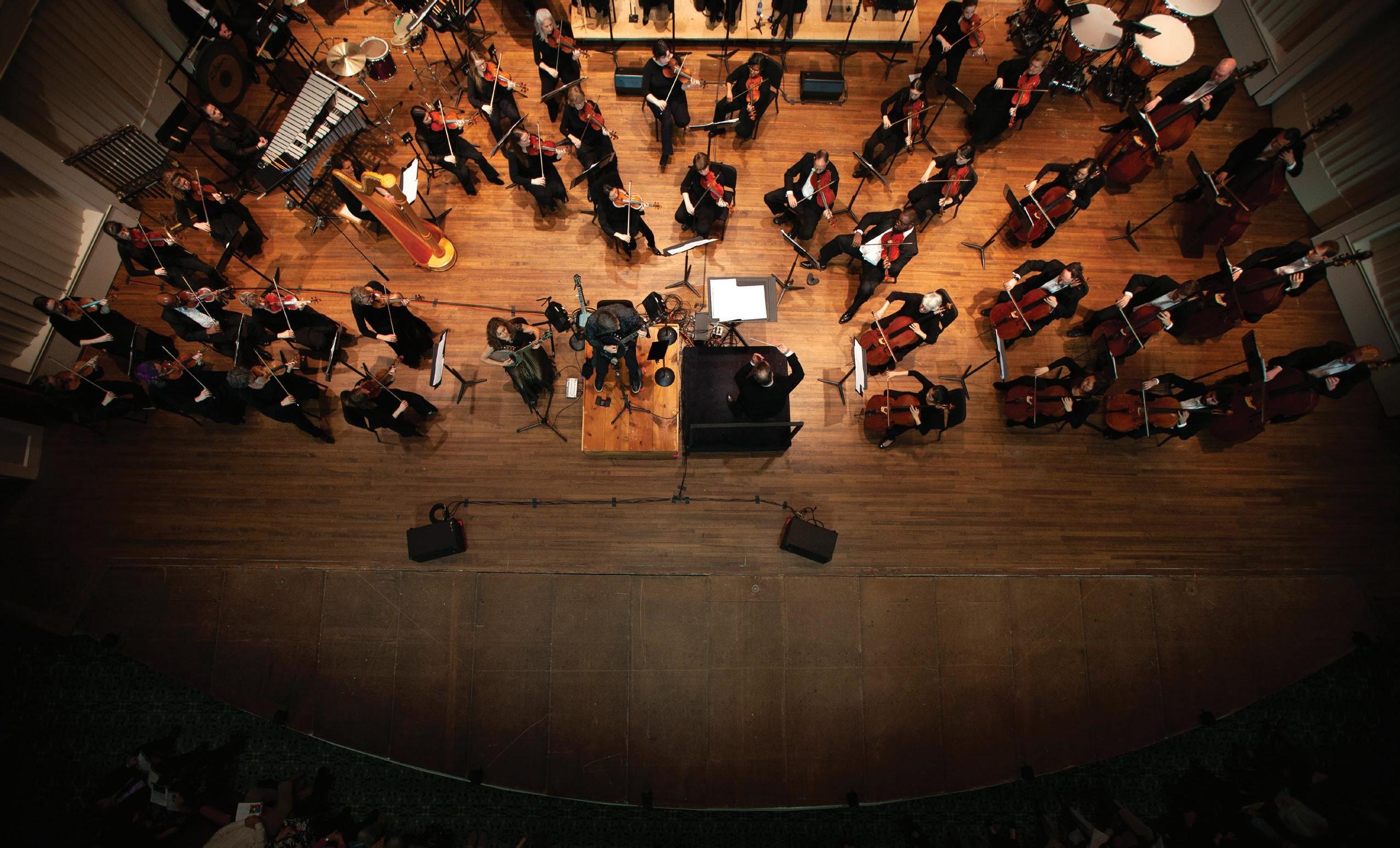
19 minute read
Ludwig: Heroes & Revolution
SATURDAY
October 3
Advertisement
Online Premiere @ 7:00 pm
my.sphil.org/watch
2020
Symphony no. 1 in G Major, op.11 . . . . . . . . . . . . . . .
String Quartet no. 5, Parks
II. Klap Ur Handz . . . . Daniel Bernard Roumain arranged for string orchestra by the composer 7 min
Ludwig van Beethoven 45 min
I.
II.
III.
IV. Allegro con brio Marcia funebre. Adagio assai Scherzo. Allegro vivace – Trio Finale. Allegro molto – Poco Andante – Presto

Symphony no. 1 in G Major Joseph Bologne Chevalier de Saint-Georges (1745-1799)
It is a sad but undeniable fact that musicians nowadays are way more boring than they used to be. Oh, sure — Stefan Sanders, just for instance, is an accomplished chef (see page 18) and a witty and genial conversationalist. But trust me, folks: he’s no Chevalier de Saint-Georges.
The Chevalier was born Joseph Bologne on the French Caribbean island of Guadeloupe in 1745. His father, Georges Bologne, was a minor French nobleman and plantation owner there; his mother, Anne, was a young enslaved Black woman of Senegalese descent. Most children born in such circumstances were, of course, studiously ignored by their fathers; by contrast, young Joseph was packed away to boarding school in Paris at the age of seven, and two years later his both his parents followed him to Paris, where they set up house in a spacious apartment on the left bank. France’s “Black Laws” forbade his parents to marry and prevented Joseph from inheriting his father’s title, but the young man was raised as a gentleman and mastered the arts of swordsmanship and horsemanship.
He gained his first fame as a fencer, defeating some of France’s most celebrated swordsmen while still just a teenager and becoming a hero to Paris’ nascent antislavery movement by casually conquering powerful opponents who peppered him with racist insults. Louis XV became such an admirer that in 1766 he made the young man an officer of the Royal Bodyguard and bestowed on him the honorific “Chevalier de Saint-Georges,” after the estate on which he was born. His grace and charm made him a favorite of the ladies of Versailles, but the Black Laws prevented him from ever marrying a woman of his own social station.
Remarkably — and evidently in his spare time at military school — Joseph managed to become a virtuoso violinist. The eminent Parisian composer Gossec dedicated a set of string trios to him in 1766, and in 1769 Parisian high society was amazed when, in Gossec’s new orchestra, the Concert des Amateurs, they saw in the first violin section the celebrated swordsman St.-Georges. He created a sensation three years later when he first appeared as a soloist with the orchestra, “enrapturing particularly the feminine members of the audience” in concertos of his own composition. The next year he assumed leadership of the orchestra, and when in 1776 a new director of the Paris Opera was needed, St.-Georges was the obvious choice.
Three of the Opera’s leading ladies, however, begged to differ. They petitioned Queen Marie Antoinette to the effect that their sensibilities would prevent them from receiving direction from a “mere mulatto,” and St.-Georges withdrew his name to avoid involving the queen in a scandal. He returned to the Concert des Amateurs, honing that group until they were recognized as one of Europe’s
best ensembles, until it went bankrupt in 1781 (in that year St. George’s friend Beaumarchais, playwright of both The Marriage of Figaro and The Barber of Seville, persuaded the orchestra’s backers to fill fifty ships with armaments and send them to the American revolutionaries). Beaumarchais was under the impression that the grateful Americans would refill the ships with rice and grain to be sold in Europe, but our Founding Fathers sent the ships back empty, a number of liberal-minded and previously-wealthy Parisians were ruined, and the Concert lost its funding.
Like his contemporary, Mozart, St. Georges had joined the Freemasons in the 1770’s, and it was wealthy Masons who saw to it that he landed on his feet with a new orchestra of his own. He commissioned and premiered Haydn’s six “Paris” symphonies in 1785 — only to see his career take another sudden turn. His old military-school chum Philippe of Orléans was by that time a duke, the second-most powerful man in France, and the leader of what was then the political opposition to Louis XVI’s absolute monarchy. Louis, sensing his own vulnerability, sought to triangulate by sending St.- Georges on a diplomatic mission to London, where the Prince of Wales had long expressed desire to meet and learn from the celebrated swordsman and virtuoso. Not one to be outmaneuvered by a mere king, St.-Georges became a great friend of the Prince, courted him as a supporter of Philippe’s plan for a constitutional monarchy, and built relations between France’s small but vocal antislavery lobby and England’s more-developed Abolitionist movement .
When in 1789 the Revolution came, St.-Georges found himself sufficiently marginalized by his time in London that
Below: a fencing match between Saint-Georges and renowned spy Mademoiselle Charles le Chevalièr D’Eon on April 9, 1787

he was unable to propel the politically moderate Phillippe into a position of power. And while St.-Georges may have had misgivings about the revolutionaries’ increasing radicalism, he could not but have been delighted when they rescinded the Black Laws and he finally had the full rights of a French citizen. So, when Austria massed troops for an invasion a year later, he was happy to assume command of a newly-created regiment of Black soldiers, the Légion St.-Georges.
St.-Georges’ regiment served bravely, but as the longtime confidante of the hated Philippe of Orléans he was viewed with suspicion by the increasingly bloodthirsty revolutionaries. Betrayed by his lieutenant ThomasAlexandre Dumas (father of the Three Musketeers author), St.-Georges found himself imprisoned during the worst of Robespierre’s reign of terror, but in 1794, before the composer could be executed, Robespierre himself was led to the guillotine, the revolutionary fever broke, and St.- Georges was released. He immediately led a delegation to Haiti, in an unsuccessful attempt to mediate the bloody slave rebellion there, ultimately wound up back in Paris at the head of another orchestra in 1796, and finally died of bladder cancer in 1799. It’s unarguably the stuff of movies, and in fact Disney subsidiary Searchlight Pictures will release a biopic sometime in 2021.
In the meantime we have St.-Georges’ music. Not a lot of it, mind you: given the exhaustingly eventful life he lived, it’s not surprising that he left only a handful of instrumental pieces and a few fragments of operas. Like that of many of his colleagues, it’s long been obscured by that of his acquaintances Haydn and Mozart. But whereas their music’s relative complexity foreshadows Beethoven and the Romantics — a big part of the reason it was so venerated by 19th Century audience — St.-Georges’ music epitomizes the gentlemanly virtue of bonne grace. Understated and deceptively simple, it piques the interest not with the emotionality of Mozart or the rhythmic gamesmanship of Haydn but with smaller, subtler virtues: a surprising melodic leap here, an unexpected turn of phrase there. This Andante, the central movement of one of two short symphonies the composer premiered in 1777, is scored for strings alone and set in the noble key of D Major and in a limpidly clear two-part form. Here, as he did in all those duels, St.-Georges makes it look easy.
Chris Vaneman Contributing Author

proud sponsor of the Spartanburg Philharmonic 2020-2021


String Quartet no. 5 PARKS Daniel Bernard Roumain (1970-)
“People always say that I didn’t give up my seat because I was tired, but that isn’t true. I was not tired physically, or no more tired than I usually was at the end of a working day. I was not old, although some people have an image of me as being old then. I was 42. No, the only tired I was, was tired of giving in. I knew someone had to take the first step and I made up my mind not to move. Our mistreatment was just not right, and I was tired of it.” — Rosa Parks
“As a Haitian-American composer, I was raised by Haitian immigrant parents who experienced American life both before, and after, the Civil Rights Act of 1964,” Daniel Bernard Roumain (DBR) said about his 2005 “Parks” quartet in program notes for the contemporary music collective 45th Parallel Universe, which sponsored his music in a 2019 Old Church concert in Portland. “Their views were informed by life on a free island nation in Port-au-Prince, Haiti; life in the suburbs of Chicago; and life in the complex diversity of Pompano Beach, Florida. They identified with Malcolm and Martin, Maya and Rosa, and the great Haitian warriors, Makandal and Toussaint. Civil rights, for our household, was global, local, and part of the very fabric of our lives and culture. I created `Rosa Parks Quartet’ as a musical portrait of Rosa Parks’ struggle, survival and legacy.”
45th Parallel Universe also described the quartet saying, “the first movement, I Made Up My Mind Not to Move, suggests Parks’ act of defiance not with ponderous dignity but with a strong ostinato that denotes grit, strength and confrontation. The second movement... Klap Ur Handz asks the players to actually clap, a feature DBR says was inspired by hip-hop rhythms but dates back to the [communal] music of Cro-Magnon man.”
DBR goes on to say, “The music is a direct reflection of a dignified resistance. It’s telling that this work may, in fact, be performed on stages that didn’t allow the presence of so many, so often. I often refer to the stage as the last bastion of democracy, where all voices can and should be heard, where we are all equal, important, and necessary.
However, as a Black, Haitian-American composer, so much of my work continues to suffer within a field that is not inclusive or compassionate.
Classical music remains racist.
Classical music organizations continue to disenfranchise BIPOC people, and not only BIPOC audiences, but their families and our audiences and our communities. Not nearly enough progress has been made.”

Above left: Rosa Parks and journalist Nicholas Chriss sitting at the front of a city bus after court ordered integration, Montgomery, AL, December 21, 1956

LOCAL HEROES
Thomas “Fox” Abrams
1951 • U.S. Navy Veteran who became the first black police officer in the Spartanburg Police Department
George “Tee” Foster & William “Big Boy” Campbell
1960 • led the historic Spartanburg Woolworth’s Sit-In that inspired dozens more demonstrations throughout the city
Hon. Matthew J. Perry
1963 • led the successful court case to integrate Clemson University
1979 • became the first black US. District Judge in South Carolina
excerpt from South of Main by Beatrice Hill & Brenda Lee
Wynona Douglas
1964 • daughter of Dr. J. Marion Douglas and Gladys Kirkland Douglas, who enrolled Wynona in Spartanburg High School where she became the first black student to attend a white public school in Spartanburg
Albert Gray
Freida Rogers & Margaret Jones
Rebecca Shell
1970 • first Miss Black South Carolina
Louvenia Black-Perkins
1979 • designed the first “Black Barbie,” the first doll of color from Mattel to have the name Barbie.

Statement on Racial Discrimination
The Spartanburg Philharmonic is a proud member of the League of American Orchestras, and we support the following Statement.
Through listening to underrepresented voices in our field; centering equity, diversity, and inclusion (EDI) in our programs and convenings; and researching our shared history and heritage, the League of American Orchestras is developing an understanding of the breadth and depth of systemic racial inequities that exist in the orchestra field.
The current pandemic and the growing recognition of disproportionate police violence against Black people shine a light on America’s long history of systemic inequities for the Black community in particular. This history includes chattel slavery, Black Code and Jim Crow laws, redlining, school segregation, voter suppression, and the prison-industrial complex. This challenging history and the current environment make it essential for us to assert our deepening commitment to be an advocate for and a credible partner with Black people and associated organizations as we seek a more equitable and diverse future for America’s orchestras.
The League of American Orchestras acknowledges, accepts responsibility for, and apologizes for the role it has played in perpetuating, excusing, and participating in systemic discrimination based on race within the orchestral field.
The staff and Board of Directors of the League have failed to sufficiently understand that systemic antiBlack racism and its resulting discrimination are rooted in a belief system, white supremacy, into which all of us, and the field itself, were born. Consequently, the League has not been sufficiently engaged in challenging this racism within the broader field and the exclusion of this community as full participants.
The impacts of our actions have included the loss of valuable musical and other creative contributions by generations of Black people, the disenfranchisement of fellow Americans, and redirected career trajectories, all resulting in fewer people engaging with the musical culture we all share and love. This ultimately diminishes the vibrancy of the art form and, therefore, undermines the orchestral experience for everyone.
The League recognizes the existence of many forms of discrimination in America that hurt our fellow human beings. In additional to race, these include discrimination based on ethnicity, age, sex, sexual orientation, gender identity, disability, religion, and socio-economic status. The orchestra field must continue its fight against all forms of discrimination to help heal our society and allow all people to be fully seen and heard.
In America, the symphony orchestra field includes youth, community, academic, and professional orchestras; conductors; administrators; musicians; volunteers; board members; and unions. The field has allowed injurious practices and tropes to persist, such as the unfounded and disrespectful belief that diversity
of personnel and/or programming can only be achieved at the expense of quality. The field has also played an active role in excluding Black musicians, composers, administrative staff, community members, and audience members from auditioning, creating, performing, managing, governing, and even listening to orchestral music. These actions stem from our country’s history of racism, which results in racial and ethnic discrimination. These actions are also counter to our belief in the shared value of all music to, by, and for all people.
We believe we must respond with meaningful action to the entrenched reality of systemic discrimination toward Black people in American orchestras that has led to their significant underrepresentation in all roles in our field.
All orchestras, each in and with their own communities, must discover their unique paths to greater inclusion and equity, which will allow them to better see, understand, and engage all of their diverse stakeholders.
We understand racism is structural and can be practiced by people of all races. It is not the primary responsibility of people of color to explain where whitedominant institutions have fallen short, or to educate those institutions on how to become more equitable in practice. We must bravely face our past failures and acknowledge the generational harm caused by them. We hold ourselves accountable and invite our members to do the same.
Therefore, we declare our commitment to inclusion and reconciliation. We choose to move fully and without delay toward absolute diversity and equity within our field; and henceforth to respect the value and boundless creative capacity of every human being.
This statement was adopted by the Board of Directors of the League of American Orchestras at its June 25, 2020 meeting.
Officers
Chair | Douglas M. Hagerman, Milwaukee, WI Co-Vice Chair | Melanie Clarke, Princeton, NJ Co-Vice Chair | Steven C. Parrish, Westport, CT Secretary | Aaron A. Flagg, Easton, CT Treasurer | Burton Alter, Woodbridge, CT
Board of Directors
Alberta Arthurs, New York, NY Kathryn Boucher, Spartanburg, SC Lorenzo Candelaria, Nashville, TN Rosina Cannizzaro, Colchester, VT Gloria dePasquale, Narbeth, PA Charles Dickerson III, Los Angeles, CA Marisa Eisemann, MD, Dorset, VT Gary Ginstling, Washington D.C. Marian Godfrey, Philadelphia, PA Mary Louise Gorno, Chicago, IL. Jim Hasler, Oakland, CA Mark Jung, Wellesley, MA Cindy Kidwell, Tyler, TX Jennifer Koh, New York, NY Hugh W. Long, New Orleans, LA Kjristine Lund, Seattle, WA Mason Alan Mason, Healdsburg, CA Anthony McGill, New York, NY David Alan Miller, Albany, NY Jennifer Mondie, Washington DC Alfred P. Moore, Minneapolis, MN Catherine C. Moye, Spokane, WA Lowell J. Noteboom, Minneapolis, MN Howard Palefsky, Atlanta, GA Mary Patton, New York, NY Mark Peacock, MD, Nashville, TN Henry Peyrebrune, Cleveland, OH Alan Pierson, New York, NY Patricia A. Richards, Salt Lake City, UT Jesse Rosen, New York, NY David M. Roth, Hartford, CT Daniel Bernard Roumain, Harlem, NY Helen Shaffer, Houston, TX Pratichi Shah, Chevy Chase, MD Daniel Song, Los Angeles, CA Trine Sorensen, Palo Alto, CA Isaac Thompson, New York, NY Alan D. Valentine, Nashville, TN Penny Van Horn, Chicago, IL Robert J. Wagner, Boonton, NJ David Whitehill, Asheville, NC Sheila J. Williams, Newport, KY Edward Yim, New York, NY

Symphony no. 3 in E b Major EROICA Ludwig van Beethoven (1770-1827)
It is difficult almost to the point of impossibility to find a portrait of either Haydn or Mozart in which the composer wears no periwig, the elaborately powdered and pigtailed wig that was a sartorial requirement among Europe’s politer classes in the later part of the 18th Century. By contrast, the striking feature in most portraits of Beethoven is the untamed, leonine mane of brown hair that leaps wildly from the composer’s head. This seemingly trivial coincidence is actually pregnant with significance, for it was Beethoven who freed Western music from the constraints of propriety and moved it into the realm of free an direct emotional expression — where, to most of us, it still lives. And this change didn’t happen gradually over the course of Beethoven’s career: it came all at once, with only a little foreshadowing in his earlier works, in the Eroica Symphony.
Beethoven’s music and life had reached a crisis in late 1802, in the Austrian spa village of Heiligenstadt. There the composer gave up at last on the treatments he had been seeking with increasing desperation, and acknowledged, in a confessional letter to his brothers, the inevitability of his encroaching deafness:
What misery when anyone beside me hears a flute in the distance, and I heard nothing, or when others heard a shepherd far singing, and still I heard nothing!
Such things brought me to the edge of desperation, and well-nigh caused me to end my life. Art! Art alone deterred me. How could I possibly quit the world before bringing forth all that I felt it was my vocation to produce!
Before this so-called Heiligenstadt Testament, Beethoven seemed to be making a continual effort to direct his unruly Muse into the channels established by Mozart and Haydn, using their comparatively restrained harmonic language and attention to orderly rules of musical construction. But in Heiligenstadt, Beethoven resolved that he would live to express himself with little regard for the accepted rules of composition or for his audience’s expectations. The Eroica was the first of Beethoven’s major works to fired entirely in the forge of personal expression. In it Beethoven’s hair had well and truly been let down; it is the first Romantic piece of music.
The Eroica originally bore the subtitle “Bonaparte,” Napoleon being its planned dedicatee. Beethoven was passionately dedicated to the ideals of democracy, and imagined that he saw in Napoleon one who would establish France as a republic. When the Little General had himself proclaimed Emperor, Beethoven was bitterly disappointed, and scratched the Frenchman’s name off the title page with a knife and replaced it with Eroica, “Heroic.”

But regardless of the symphony’s nominal dedicatee, there can be little doubt that Beethoven’s true topic is Beethoven himself. The symphony begins not with the slow introduction audiences of the day would have expected but with two violent, percussive E-flat chords that strike blows to the gut. At the 1804, premiere most of the audience wasn’t even aware that Beethoven was battling deafness, so they couldn’t possibly have known that the incessant and ever-worsening ringing in the composer’s ears was in fact a screamingly high E-flat. But we know it, and knowing it, we can’t help seeing the Eroica as a representation of his struggle with the fate that buffeted him so cruelly. Neither could they have known of his serious contemplation of suicide in the not-too-distant past. But we know that, too, and knowing it, we can’t help being moved and a little unnerved by the second movement funeral march. And neither could they have foreseen the extent of Beethoven’s eventual triumph, composing the Ninth Symphony in a state of total deafness. But we know that, as well, and we can’t help being inspired by the Eroica’s finale.
The piece is undeniably complex. From the wildlyfluctuating moods of the 16-minute opening movement to the startling and poignant slow episode that interrupts

its finale, it’s almost twice as long as most symphonies of its day. And whereas most music of its day worked to capture a single mood or emotion in a given movement, the Eroica veers rapidly between joy and sorrow, buoyancy and foreboding, just like real life does. Beethoven “takes at times the majestic flight of an eagle, and then creeps in rocky pathways,” according to a French critic in 1810. “He first fills the soul with sweet melancholy, and then shatters it with a mass of barbarous chords. He seems to harbor together doves and crocodiles.” His biographer Fernand Ries tells of an early performance wherein the composer himself was conducting, actually got lost in his his own first movement, and had to stop the orchestra and regroup.
And it’s long. To a few of the periwigged voices of musical propriety at its premiere, it was too long and too wild: “The Heroic Symphony contains much to admire,” wrote the Harmonicon of London, “ but it is difficult to keep up the kind of admiration. If this symphony is not by some means abridged, it will soon fall into disuse.” Needless to say, the Eroica did not fall into disuse, but rewrote our very idea of what music is for. As of that night, music was free to express unfettered emotion, and it would never again be the same.










